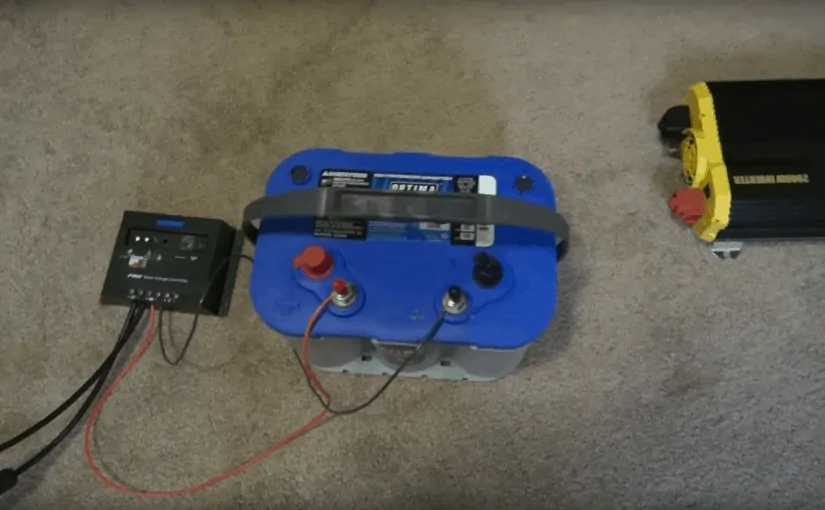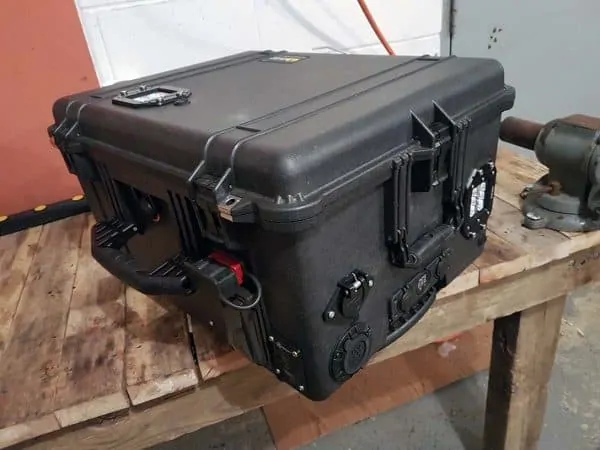This is part two in our series of posts on how to build your own large (2,000 Watt, 4,000W Peak) solar generator.
Testing the Components of Your Solar Generator
Before we start mounting all the various electronic components into the Pelican case for our solar Generator, it is a good idea to make sure everything is working correctly. We definitely would not want to discover we have a defective invertor only after mounting it and wiring everything else up around it.
In the video I will show you how to bench test the following components:
- Kreiger 2000W / 4000W Peak AC Inverter
- Renogy 100 Watt Solar Panel & Charger Kit
- Optima Blue Top 8016-103 Battery
- Schumacher SE-1-12S-CA Fully Automatic Onboard Battery Charger
- NOCO Genius GCP1 Black 13 Amp 125V AC Port Plug
- Nilight 2pcs 18w Flood Led Work Lights
Main Components for the Solar Generator
To see the full list of components used in this build, see Part 1 – How to Build a Large solar Generator
Click here for Part 3 – “Mounting the Internal and External Components” for the Solar Generator!



I’m building this 4000w unit but I’ll be needing more power in the upcoming months. I’m wondering, if I were to, say build 4 of these inits for my home, is there a way to connect them all, or would it make more sense just to add more batteries and panels ?
Would this work with the Kreiger’s newer 4000W?
i dont find the inverter remote control switch, not in the parts list. Please advise . would be greatly appreciated.
It comes with the inverter. Not all investors come with remotes.
That would be inverters, not investers…
I really have enjoyed the 3000w DIY solar generator plans. But I also like to read reactions and saw the “Another 3000W Solar Generator” I know there probably is no video for this newer version , BUT, can the author supply any details of why certain items were replaced with his new parts list.. .. AND….whether, because of the different parts, their positions change inside the Pelican. I have begun purchasing parts, and would like to change out the ones which make sense to me. Thanks, Mitch
Hi Mark,
I watch one of your Video on how to build a Portable Solar Generator }3000 Watts]
I was amazed, your work is very good and I want to do the same.
My question is, can this 3,000 watts Portable Solar Generator carry the loads of appliances like
1. Big Deep frizzier.
2. Big Photo copy machine like RICOH AFICIO MP 2000.
3. Big Printer like HP LaserJet 2840.
4. Plumbing Machine.
Otherwise can you build 8,000 watts Portable Solar Generator?
I used numbers 1-3 in my Computer Centre with petrol Generator, I am tired of using petrol generator because of its loud sound.
Where in Nigeria I can get your Agent to buy this Portable Solar Generator?
Please, I need your reply.
Thanks very much.
ADEJINMI SAMUEL O.
08066493479 ]SMS ONLY]
Part 3 is up!
https://www.modernsurvivalists.com/build-large-solar-generator-part-3-component-mounting/
Great Pics! Appears to have been definitely worth the wait.
Still here Mark! Looking forward to it
Thanks Scott! The filming is done and I am working on editing the video now.
I am really happy with the way it went together. Here are some sneak peak pics:
https://www.modernsurvivalists.com/wp-content/uploads/2016/10/large-solar-generator-1.jpg
https://www.modernsurvivalists.com/wp-content/uploads/2016/10/large-solar-generator-2.jpg
https://www.modernsurvivalists.com/wp-content/uploads/2016/10/large-solar-generator-weather-proof-outlet.jpg
Looking forward to part 3!!
Status update: I am in the middle of filming part 3. It has been a little slow going, as my day job keeps getting in the way! I will get it done though, thanks for everyone’s patience!
I WAS THINKING IT WAS 2017 FOR SOME REASON, SORRY. i AM JUST CURIOUS ABOUT THE PLUGS FOR THE USB AND EVERYTHING HOW YOU WERE GOING TO HAVE ACCESS TO THOSE ON THE OUTSIDE?
Thanks for the comment!
Don’t worry, all loads will be properly fused in the wiring of the solar generator. I didn’t bother with fusing for the component testing video for simplicity and because the connections were temporary. If something shorted or a wire started to overheat during the short test I was right there to immediately disconnect it.
On the solar panel & charger, we will need a fuse on the circuit between the solar charger and battery, since a short here will have the full current capacity of the battery, but on the solar panel side a fuse is actually not needed for a single panel setup. Multiple parallel wired panels may need a fuse, but a single panel or even series wired multiple panels do not have the current capacity to exceed the 30A rating of our 10 gauge wire. And these panels can actually be directly shorted in full sunlight without suffering any ill effects. See http://forum.solar-electric.com/discussion/15385/shorting-a-solar-panel and https://www.windynation.com/jzv/inf/how-properly-fuse-solar-pv-system if your curious to learn more about panel fusing requirements!
Any update on upload of the third installment of the series? I’ve pretty much acquired all of the materials and would like to see how you’ve tied it all together. THank You, Scott
Thanks for your patience Scott! I hod hoped to have had all the posts for this series up by now, but seemed like higher priority kept coming up. I will try to get the next step, mounting the components in the case, up in the next week. Then the next and final step will be wiring everything together.
I made a small misquote fuse the solar panels to protect the panels not the charge controller!